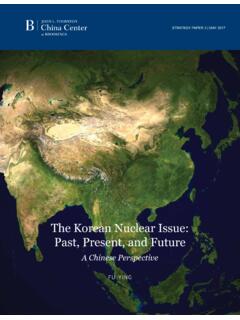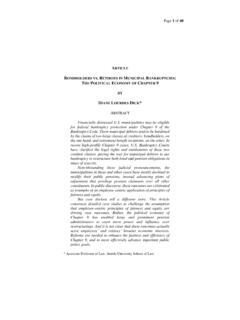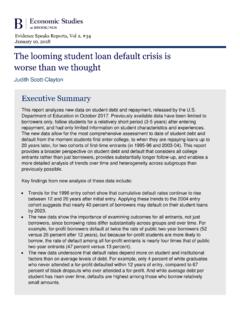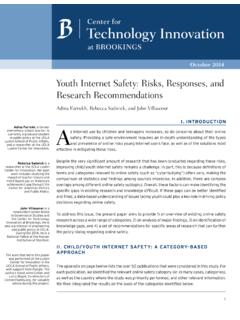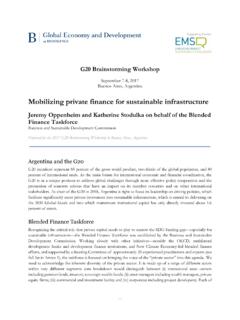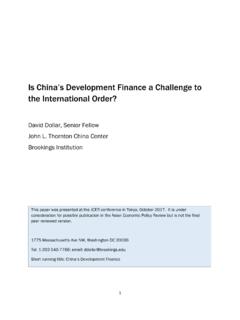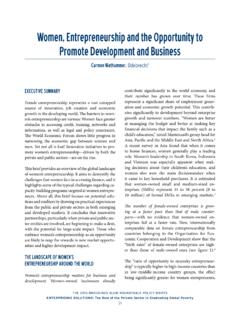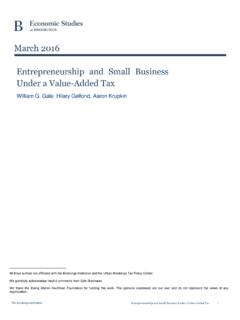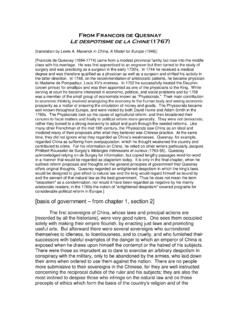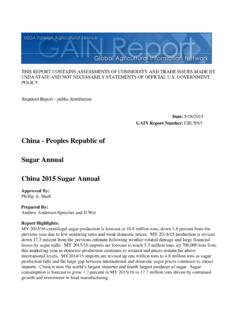Transcription of Shadow banking in China: A primer - Brookings
1 Shadow banking in China: A primerDouglas Elliott, The Brookings Institution, Economic StudiesArthur Kroeber, The Brookings -Tsinghua CenterYu Qiao, The Brookings -Tsinghua Center March 2015 The rapid development of China s Shadow banking sector since 2010 has attracted a great amount of commentary both inside and outside the country. Haunted by the severe crisis in the US financial system in 2008, which was caused in part by the previously unsuspected fragility of a large network of non-bank financial activities, many analysts wonder if China might be headed for a similar meltdown.
2 The concern is especially acute given China s very rapid rate of credit creation since 2010 and the lack of transparency in much off balance sheet or non-bank paper will address the following questions: What is Shadow banking ? Why does the sector matter? What was the Chinese credit system like before Shadow banking ? What is the nature of Shadow banking in China now? How big is Shadow banking in China? Why has Chinese Shadow banking grown so fast? How does Chinese Shadow banking relate to the formal banking sector?
3 Why has the Chinese sector developed as it has? How does the size and structure of Shadow banking in China compare to other countries? Will there be a major Shadow banking crisis in China? How do Chinese authorities intend to reform Shadow banking ?The authors would like to acknowledge the assistance of a number of experts, including Jason Bedford, Darrell Duffie, Stephen Green, Wei Hou, Dinny McMahon, Logan Wright, and Kai Yan. In addition, several reviewers chose to remain anonymous. The authors, of course, are solely responsible for any errors in this Brookings InstitutionShadow banking in China 1 Executive SummaryShadow banks are financial firms that perform similar functions and assume similar risks to banks.
4 Being outside the formal banking sector generally means they lack a strong safety net, such as publicly guaranteed deposit insurance or lender of last resort facilities from central banks, and operate with a different, and usually lesser, level of regulatory oversight. These characteristics increase the risks for financial stability, which is the main reason there is a focus on Shadow banks banks can help spur economic growth by making financial services cheaper and more widely available, but there is usually a trade-off in terms of reduced financial stability.
5 One reason for the trade-off is that Shadow bank s flexibility and price competitiveness often comes at the expense of safety margins. Banks, for example, are generally required to have significantly more capital and liquidity than Shadow banks may choose to carry. Shadow banks are also less regulated. This combination forces policymakers into difficult balancing acts to try to maximize the benefits while minimizing the banking in China must be viewed in the context of a system which remains dominated by banks, especially large state-controlled banks, and in which the state provides a great deal of direction to banks, through a variety of regulations and formal and informal guidance.
6 In the last few years, those constraints have become sufficiently binding that business has flowed to Shadow banks. There are a number of pressures pushing business away from banks towards Shadow banks, including the fact that: There are caps on bank lending volumes imposed by the People s Bank of China (PBOC). The limit of bank loans to deposits of 75% is constraining. Regulators discourage lending to certain industries. Most non-bank channels have lower capital and liquidity requirements. Shadow banks are not subject to bank limits on loan or deposit rates.
7 Shadow banking avoids costly PBOC reserve requirements. Perhaps two-thirds of the flow of business into Shadow banking is effectively bank loans in disguise, where a bank is at the core of the transaction and takes the great bulk of the risks and rewards, but pays non-banks to participate in order to avoid regulatory constraints and costs. The other third or so of the business that has moved results from a combination of competitive advantages for the non-banks, many due to looser regulation, and a willingness and ability to reach out to smaller, private sector businesses that are not well-served by the banking transactions generally make use of one or more of the following techniques and instruments:Loans and leases by trust companies.
8 Trust companies are financial firms in China that have a quite flexible charter and combine elements of banks and asset loans. These are loans made on behalf of large corporations, using banks or finance companies as intermediaries. They are most commonly to other companies in the same group or to suppliers or customers. There is also an interbank version, where one bank will act on behalf of Acceptances. These are notes issued by banks that promise to pay a fixed amount a few months in the future. Generally these are supposed to be issued in connection with a non-financial transaction, such as a purchase of goods, but reports suggest they are often used more companies.
9 These are separately regulated financial firms that are licensed to lend in small amounts to help encourage credit access for small and rural borrowers. Financial leasing. This represents leasing of all kinds that is not already on a bank or trust company balance sheet and is not a short-term operating Guarantee companies in China provide financial guarantees, including to facilitate Shadow banking transactions. Many guarantee companies have branched out to make direct loans, even though they do not have legal licenses to do shops and various unofficial lenders.
10 Pawn shops are important lenders to some households and small businesses. In addition, there are other types of lenders that operate informally or even clearly illegally. Trust Beneficiary Rights (TBRs). TBRs are effectively a simple form of derivative transaction whereby the purchaser of the TBR receives all or a stated proportion of the returns accruing to a trust. Banks sometimes use The Brookings InstitutionShadow banking in China 2 TBRs as part of complex Shadow banking transactions to keep the economic benefits of a loan without showing it as a loan on their balance sheets, but moving it to a more favorably treated investment category.
